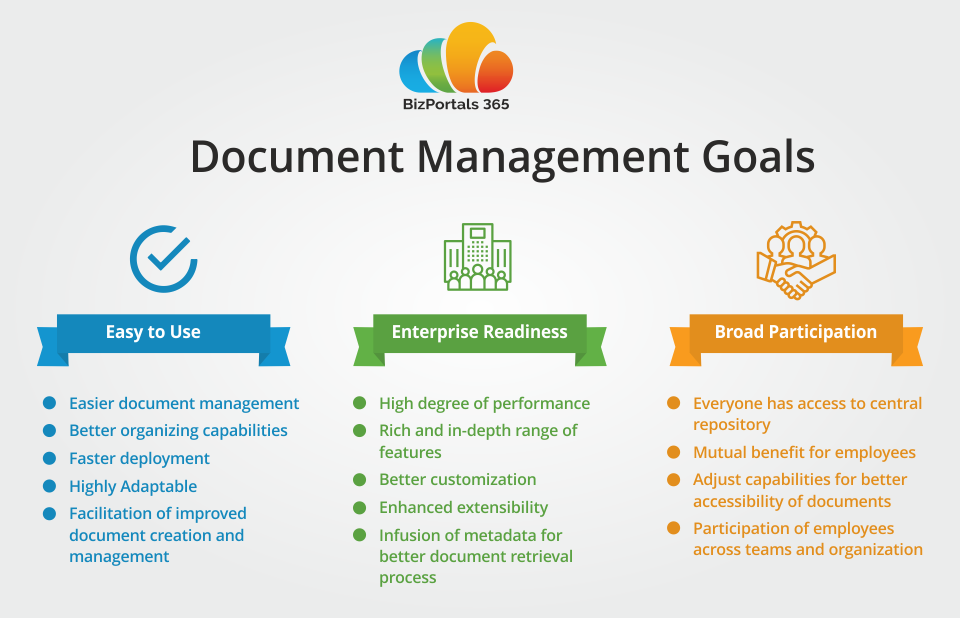A centralized platform with powerful document management features is imperative to succeed in the current business dynamics. Certainly, document management is how an organization captures, stores, organizes, and tracks its documents in either electronic or paper format. And documents when automated and managed digitally, leave no scope for inconsistencies, inaccessibility, and delayed decision-making.
Do you ever wonder how many paper-based documents are created in your organization every day? Without a digital document management system, you will have a mountain of files and run out of office space to store these documents. Research conducted by Coopers & Lybrand (now PricewaterhouseCoopers) has estimated that there are over 4 trillion documents in the U.S. alone, and the numbers are growing at a rate of 22% per year. This could be the right time to invest in a robust DMS. This blog covers in detail the features of a document management system and how SharePoint-based DMS is an optimal choice for modern businesses.
What is a Document Management System, and Why Is It Crucial for Every Organization?
A document management system offers a systematic approach to capture, store, organize, retrieve, and share documents within the organization. The essential features of a document management system, such as centralized document repository, permission-based access, versioning, and co-authoring, coupled with integrated process automation, not only improve document handling and control but also helps organizations to streamline the entire document management workflow.
With over 200 million users relying on SharePoint for their document management and collaboration needs, it has become an obvious choice for modern businesses. It offers a familiar interface, secure storage, and integrates well with different business applications. Let’s explore some powerful features of a DMS in detail:

Key Features of a Document Management System based on SharePoint
1. Document creation and storage
Centralized space for document management and control is among the top features of a SharePoint DMS. Unlike physical document storage, a DMS offers dedicated libraries that facilitate document input and creation. Users can create new documents or upload them directly to the library straight from the network drives.
SharePoint DMS features like bulk upload, file drop box, and easy drag-and-drop offer users a convenient way to populate the document library. It facilitates document input and initiates the document management workflow within the organization.
2. Anywhere access to documents
SharePoint, being a cloud-based platform, allows users to access documents from anywhere across the globe. You just need a web browser and a working internet connection. Certainly, this feature of a document management system allows distributed teams to easily upload, edit, or access documents on their device from remote locations. It enables field workers, sales representatives, and shop floor employees to access and upload information on-site, improving workplace collaboration and ensuring access to the latest information.
3. Document search and retrieval
Faster document search and retrieval ensures timely information access, reduces response time, and facilitates informed decision-making. SharePoint DMS features like document tagging help employees add relevant keywords and metadata to the files, making them easily searchable when needed simply by applying filters. Furthermore, creating dedicated libraries for different departments and project sites helps users classify specific documents, thereby reducing the cluttering of libraries.
Content type is yet another powerful feature of a document management system built on a SharePoint environment. It refers to a set of metadata that defines the characteristics of a specific type of content and can be applied to documents, list items, or folders. The metadata fields associated with content types help employees easily filter and find documents. Apart from this, setting up a utility-based hierarchy of files and folders can help users organize information in a logical manner that eases navigation and improves document retrieval.
4. Document control
Document versioning is among the most leveraged document management features by businesses operating in a regulated environment. While working with remote teams in a collaborative environment, it becomes necessary to maintain a clear record of changes made by multiple users working on a single document. Certainly, versioning helps users keep a record of who made what changes in the document and when, allowing them to restore any previous version in case of errors. This promotes accountability, helps manage audit trails, and ensures access to the most recent version of the document.
5. Document security
Along with the enterprise-grade security provided by Microsoft, a DMS built on SharePoint is equipped with a security hierarchy where site collections, sub sites, document libraries and individual items inherit their permissions from the parent site. By enabling role-based access to the platform, you can limit the users’ action based on their job-role and authority.
Department and team site permissions are controlled through Site Owners who define access to that site and what kind of access individuals have. There are four groups through which permissions are granted:
- Owners – have administrative permissions for the site.
- Granters – have read and write permissions and they can also create lists.
- Members – have read and written permissions. The user can add, edit and change documents; they can also add and delete items from a list, but cannot create new lists.
- Visitors – have read-only permissions for the site. This granular permissions structure ensures that security is maintained at various levels
6. Documents sharing
An ideal document management system facilitates seamless document sharing with internal or external users. Documents are shared with specific permissions, and the user who receives the document can only access it through the link. For example, a Marketing manager may need an employee from the Development department to review a white paper for technical accuracy. Since the developer doesn’t have access to the Marketing department site, the document can be shared with the necessary permissions.
In SharePoint-based DMS the documents inherit the permissions from its parent library or folder, but this can be changed by employees while sharing the document. It allows users to set the following permissions:
- Full Control: User can view, edit, and delete the document
- Contribute: User can view and edit the document
- Read: User can only view the document
- View: User can approve the document
7. Automated document approval
Most organizations require a formal approval process to be followed, before work can begin or is considered complete; and to standardize the procedure, a specific workflow is set in place. This saves time and takes the guesswork out of the process. Certainly, Manual document routing and approval can be time consuming, error prone, and does not provide transparency or maintain a log of activities which can be used to back track in case of mistakes. However, an automated system is the way to go.
Automated approval workflow feature of a document management system allows users to assign approvers and set conditions, while automating routing, status tracking, and reminders. This system is efficient, error-free, maintains a log of activities, and standardizes the processes.
The order of the workflow can be set to be serial; where the document routes to each approver one at a time; or parallel, where all approvers can begin their approval simultaneously.
- Approvals can be set to be initiated automatically or manually. The automatic process begins as soon as a document is created or dropped into the library and the manual process begins when a user explicitly selects a document and sends it for approval.
- Quick and timely completion of approvals can be ensured by creating timelines for people to complete their task. Approvers are sent automatic reminders when the deadlines are approaching.
Why BizPortals 365 is the best choice for Document Management System?
Now that you know what a document management system is, what its essential features are, and what makes it an irreplaceable tool, you might wonder what the best solution is for your business. Over the past ten years we have helped our customers go paperless with BizPortals 365, a Microsoft 365 powered intranet and document management solution. They are saving money (on paper and storage space) and time (on storing, managing, and searching) and are incredibly pleased with the scalability, flexibility, and mobility BizPortals 365 offers them.
Bizportals 365, a feature-rich DMS, offers seamless integration with various industry-specific business systems used by manufacturing, financial, retail, healthcare, legal, and many other verticals. More than just document management features, our SharePoint-based solution is equipped with all the essential features required to boost employee engagement, workplace collaboration, and productivity. Let’s see how BizPortals 365 DMS sets itself apart from other solutions:
1. SharePoint Architecture
BizPortals 365 is based on the SharePoint architecture, which gives it the advantage of functioning effortlessly with any system or database. SharePoint platform provides a high-quality and consistent operation which distinguishes it from other open-source architectures
2. Seamless Integration
BizPortals 365 can integrate with the most popular third-party services including Microsoft Office 365, Google Docs, email clients, etc. It’s cross-platform nature, modular architecture, and scalable components make it possible to integrate BizPortals 365 with any existing infrastructure. Many businesses that require customized functionality report it being much easier and faster to develop them on SharePoint compared to developing them from scratch.
3. Highly Customizable
The scalable backbone of BizPortals 365 also makes it possible to enhance the existing document management capabilities. For example, the user interface can be adapted to user-specific needs and widgets can be programmed to offer extended capabilities like displaying all documents in the approval process or all forms requiring approval for amounts more than $5,000 on the home page for the approvers.
With BizPortals 365, users can add custom properties/metadata for documents which can additionally be used in searches and filters. This way a wide variety of options are designed to meet the most extraordinary needs of a business with BizPortals 365.
4. Reliable Data Protection
Microsoft Office 365 allows for authentication and authorization access levels guaranteeing the security of sensitive data. BizPortals 365 enhances the access levels with its implementation of role-based access to sensitive data including documents, forms, and list data. Secure integration with external systems provides security guarantees for information including documents and transactional data flow between BizPortals 365 and Line of Business applications.
If you would like to see what the Document Management System on BizPortals 365 looks like, schedule a demo with our experts today.
Get Free Product Tour

